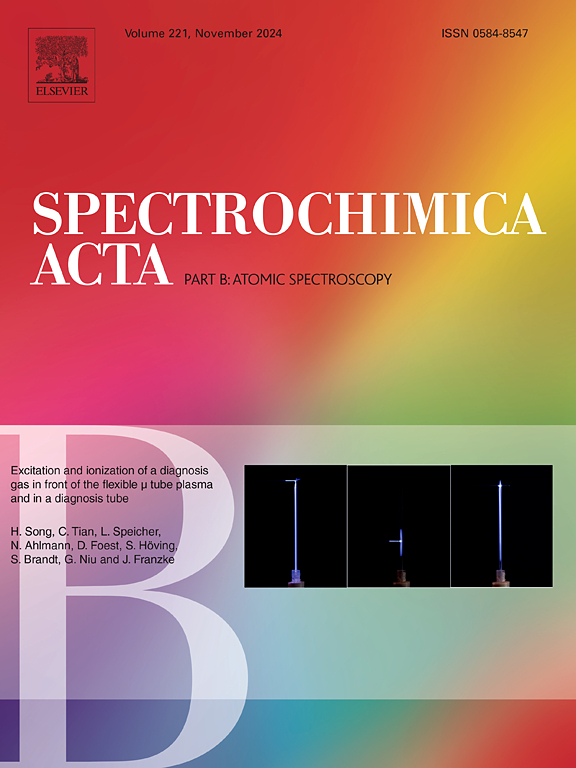Surfactant-assisted au nanostructures with Micro-hole Array sprayer for enhanced LIBS detection of trace heavy metals in water
IF 3.8
2区 化学
Q1 SPECTROSCOPY
引用次数: 0
Abstract
Heavy metal pollution threatens human health and ecosystems, and countries have established strict standards for heavy metal content in water bodies. This paper presents a new method based on micro-hole array sprayed on solid substrate enhanced laser-induced breakdown spectroscopy (MASSS-LIBS) technology and NELIBS, which enables high sensitivity and multi-element detection at the μg/L level. The method involves sequentially spraying metal nanomaterials, water samples, and surfactants onto a silicon substrate to form nanostructures that are conducive to LIBS analysis. Experimental research examined the impact of key parameters, including surfactant type and nanoparticle preparation, on signal quality. Results showed significant improvements in signal intensity and stability after forming nanostructures compared to using only Au nanoparticles. Different surfactants provided varying LIBS enhancements for heavy metals, with sodium dodecyl sulfate (SDS) demonstrating superior enhancement and stability for Pb, Cr, Cu, and Mn. Controlling nanoparticle density through spraying time for Au NPs helped manage nanostructure surface density and reduce Au nanoparticle loss, further enhancing LIBS signals. Under optimized parameters, the intensity of LIBS spectral peaks following nanostructure formation was approximately 10 times higher than that observed without nanostructures, with a stability of 6 %. The LoD for Mn reached sub-μg/L levels, while the LoD for Cu, Cr, and Pb was approximately several μg/L, demonstrating a one-order-of-magnitude improvement. In eleven quantitative inversion experiments in the low concentration range of tens of μg/L. Overall, this method shows potential as an alternative for qualitative and quantitative analyses in water quality testing.

表面活性剂辅助金纳米结构与微孔阵列喷雾增强水中痕量重金属的LIBS检测
重金属污染威胁着人类健康和生态系统,各国都制定了严格的水体重金属含量标准。本文提出了一种基于固体衬底喷涂微孔阵列增强激光诱导击穿光谱(mass - libs)技术和NELIBS技术的新方法,可实现μg/L水平的高灵敏度和多元素检测。该方法包括将金属纳米材料、水样和表面活性剂依次喷涂到硅衬底上,形成有利于LIBS分析的纳米结构。实验研究了表面活性剂类型和纳米颗粒制备等关键参数对信号质量的影响。结果表明,与仅使用金纳米颗粒相比,形成纳米结构后信号强度和稳定性显著提高。不同的表面活性剂对重金属具有不同的LIBS增强作用,其中十二烷基硫酸钠(SDS)对Pb、Cr、Cu和Mn具有较好的增强作用和稳定性。通过喷射时间控制纳米粒子密度有助于控制纳米结构表面密度,减少纳米粒子损耗,进一步增强LIBS信号。在优化参数下,纳米结构形成后的LIBS谱峰强度比未形成纳米结构时的LIBS谱峰强度高约10倍,稳定性为6%。Mn的LoD达到亚μg/L水平,而Cu、Cr和Pb的LoD约为几μg/L,显示出一个数量级的改善。11次定量反演实验均在几十μg/L的低浓度范围内进行。总的来说,这种方法显示了在水质测试中作为定性和定量分析的替代方法的潜力。
本文章由计算机程序翻译,如有差异,请以英文原文为准。
求助全文
约1分钟内获得全文
求助全文
来源期刊
CiteScore
6.10
自引率
12.10%
发文量
173
审稿时长
81 days
期刊介绍:
Spectrochimica Acta Part B: Atomic Spectroscopy, is intended for the rapid publication of both original work and reviews in the following fields:
Atomic Emission (AES), Atomic Absorption (AAS) and Atomic Fluorescence (AFS) spectroscopy;
Mass Spectrometry (MS) for inorganic analysis covering Spark Source (SS-MS), Inductively Coupled Plasma (ICP-MS), Glow Discharge (GD-MS), and Secondary Ion Mass Spectrometry (SIMS).
Laser induced atomic spectroscopy for inorganic analysis, including non-linear optical laser spectroscopy, covering Laser Enhanced Ionization (LEI), Laser Induced Fluorescence (LIF), Resonance Ionization Spectroscopy (RIS) and Resonance Ionization Mass Spectrometry (RIMS); Laser Induced Breakdown Spectroscopy (LIBS); Cavity Ringdown Spectroscopy (CRDS), Laser Ablation Inductively Coupled Plasma Atomic Emission Spectroscopy (LA-ICP-AES) and Laser Ablation Inductively Coupled Plasma Mass Spectrometry (LA-ICP-MS).
X-ray spectrometry, X-ray Optics and Microanalysis, including X-ray fluorescence spectrometry (XRF) and related techniques, in particular Total-reflection X-ray Fluorescence Spectrometry (TXRF), and Synchrotron Radiation-excited Total reflection XRF (SR-TXRF).
Manuscripts dealing with (i) fundamentals, (ii) methodology development, (iii)instrumentation, and (iv) applications, can be submitted for publication.

 求助内容:
求助内容: 应助结果提醒方式:
应助结果提醒方式:


